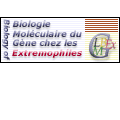
|
|















|
International Summer School
From Genome to Life:
Structural, Functional and Evolutionary approaches
KHODOSEVICH Konstantin |
|
Shemyakin-Ovchinnikov Institute of Bioorganic Chemistry, Russ. Acad. Sci., Laboratory Of Structure And Functions Human Genes, Miklukho-Maklaya 16/10, Moscow 117871, Russia title: Human-specific retroelements HERV-K LTRs: identification, phylogenetic analysis and analysis of genomic environment, estimation of quantity. Whole-genome comparison between closely related species and detection changes in the molecular evolution factors are one of the general goals of the comparative genomics, new area in biology [1]. Transposable elements are considered as one of such factors, which contribute genome evolution, especially in the evolution of vertebrates [2]. Over 41% of the human genome is represented by sequences derived from transposable elements, which transpose through RNA intermediates - long interspersed elements (LINEs) - 13%, short interspersed elements (SINEs) - 20% and long terminal repeats elements (LTR elements), most of which are endogenous retroviruses (ERVs) - 8%. ERVs, and particularly their LTRs, contain many regulatory sequences, such as promoter, enhancer, polyadenilation signal and factor-binding sites, thus, they can influence on genes expression; in other cases they can play role of splicing sites [3,4]. Through the evolution most of ERVs disappeared from a genome by homologous recombination between two LTRs with generation solitary LTR. The age of the youngest family of human's LTRs is 3,5 million years (myr), but the age of the divergence of human's and chimpanzee's evolutionary branches is 5,6 myr [5]. It's most probably that some of the members of this group, which had integrated in regulatory regions of the human genome, influenced on the expression of adjacent genes. Using powerful technique for genome-wide identification of differences in the interspersed repeats positions between closely related genomes, reported by us previously [6], we obtained whole-genome library enriched in human-specific (Hs) LTRs HERV-K (the most active ERVs group in human genome). We cloned and arrayed 500 random transformants. Then we sequenced DNAs of 55 randomly chosen clones, mapped them in human genome, and as a result identified 36 independent sequences, which was tested for the human-specificity by PCR analysis. We found 25 Hs LTRs, 23 of them being identified for the first time (with 18 previously described Hs LTRs total number of Hs LTRs HERV-K amounts to 41). Almost all of them can potentially influence to the genes expression, because they located in introns, close to promoters, enhancers or other regulatory regions known or candidate genes - FT, PDE4B, GCKR etc. Different expression in human and other animal had been reported previously for some of these genes [7]. We carried out phylogenetic analysis of sequences of all 41 known Hs LTRs and found that 40 of them have significant structure relationships, with further dividing to the subgroups. Based on the distribution of single and repeated clones among the identified Hs clones in whole-genome library and on the results of a differential hybridization, we estimated a lower limit of the total number of Hs LTRs, which comprised 67 members. References: 1 International Human Genome Sequencing Consortium. (2001). Initial sequencing and analysis of the human genome. Nature 409:860-921. 2 Sverdlov, E. D. (2000). Retroviruses and primate evolution. Bioessays, v.22, 161-171. 3 Brosius, J. (1999). RNAs from all categories generate retrosequences that may be exapted as novel genes or regulatory elements. Gene 238, 115-134. 4 Schon, U., Seifarth, W., Baust, C., Hohenadl, C., Erfle, V., and Leib-Mosch, C. (2001). Cell type-specific expression and promoter activity of human endogenous retroviral long terminal repeats. Virology 279, 280-291. 5 Lavrentieva, I., Khil, P., Vinogradova, T., Akhmedov, A., Lapuk, A., Shakhova, O., Lebedev, Y., Monastyrskaya, G., and Sverdlov, E. D. (1998). Subfamilies and nearest-neighbour dendrogram for the LTRs of human endogenous retroviruses HERV-K mapped on human chromosome 19: physical neighbourhood does not correlate with identity level. Hum Genet 102, 107-116. 6 Buzdin A, Khodosevich K, Mamedov I, Vinogradova T, Lebedev Y, Hunsmann G, Sverdlov E. (2002). A Technique for Genome-Wide Identification of Differences in the Interspersed Repeats Integrations between Closely Related Genomes and Its Application to Detection of Human-Specific Integrations of HERV-K LTRs. Genomics 79(3):413-22. 7 Perez-Torres, S., Miro, X., Palacios, J. M., Cortes, R., Puigdomenech, P., Mendog, G. (2000). Phosphodiesterase type 4 isozymes expression in human brain examined by in situ hybridization histochemistry. J Chem Neuroanat 20(3-4), 349-374. |